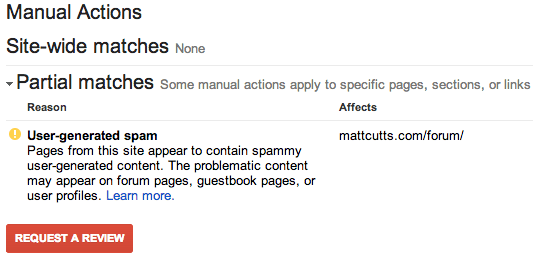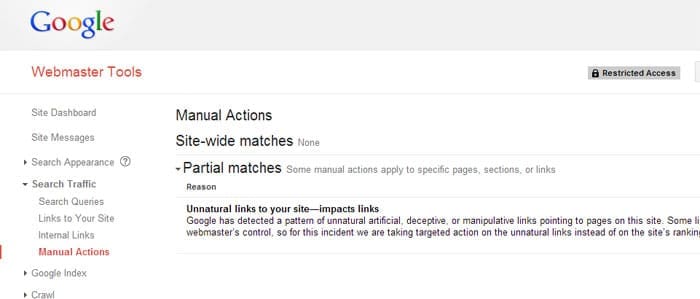Several months ago, Google promised us that they would start providing additional information for websites that were hit by manual penalties for webspam.
There are many types of manual penalties that they employ, nearly all related to quality issues a’la Panda and Penguin.
Webmasters, SEOs, and Web Marketers alike have been waiting patiently (and some not-so-patiently) for when Google finally came through on that promise.
Well, they no longer have to wait.
Manual Penalties for Webspam Added to Google Webmaster Tools
On August 8, 2013, Matt Cutts himself announced via the Google Webmaster Tools (GWT) blog that manual webspam actions are now documented in GWT.
This feature is something we’ve all been waiting for, so let’s look at what they are providing within it.
Site-wide vs. Partial Matches
We have had a major blind spot over the past two years in delineating between algorithmic hits and manual webspam penalties.
In addition to providing confirmation on when a penalty is manual, Google is sharing whether it is a site-wide issue or only on part of the website.
This is a very useful piece of information.
Several clients of ours have experienced a loss of traffic for only certain keywords or pages on their sites since Penguin 2.0 hit.
Initially, we had to do a lot of speculating, but it was still guesswork.
Now, Google is providing information for not only whether it is impacting the entire domain or not, but also some guidance as to which parts of the site are being impacted.
See the below example from the original announcement on the GWT blog:

Manual Penalties for Link Manipulation
We already know that shady link building practices have been under siege ever since Penguin 1.0 launched in April 2012.
While the objectives of the whole Penguin initiative are good, remediating its impact has proven to be hit or miss for many websites.
Now, we finally have information about not only what was hit, but also how. We know if the linking issues affect an entire domain or not.
We know if a section of the site is impacted or not. And now, we know if only the link profile has been affected. See the feature image above for an example of how this looks in GWT.
This is a big deal. If the domain or specific pages on the domain are not overtly penalized, that’s a much easier problem to fix.
Basically, if some subset of the links is the only thing that has been affected, it simply means that not all of your links are driving link juice.
As your overall link profile grows, assuming it is grown within Google’s guidelines, the link equity will begin to increase again over time.
It reduces the urgency to beg sites to remove links (which often results in no reply or a fee for the time and effort) or turn to the Disavow tool.
Sure, you can still go through the motions of removing those links, but Google is basically suggesting that it’s already done for you.
This is more helpful than is apparent on first glance.
You can also find a couple of sample links here, when Google chooses to share that information.
Just as the above screenshot shows which on-site URL is affected, you would see off-site links that are questionable in the right column.
What Parts of Your Site Are Low Quality
Turning to Panda and its on-site quality objectives, we now have better insight into whether only certain parts of your website have been hit for low quality.
For partial site manual penalties, GWT now shows you where the problem is.
User generated content and spammy comments/forum posts are a huge issue for some websites.
These were logical first places to look in the past when you were suspicious of a Panda penalty. Now we know for sure if that’s the case or not.
Summary
We finally have more insight into manual penalties from Google via GWT.
No matter whether you’ve been sent a notice of penalty by Google or not, it pays to keep an eye on the “Manual Penalties” page within your own account.
None of us want to be hit with a penalty, but when it does happen, the faster we can address it, the better.
They even chose to include a “Request Review” button, making the process much easier than it has been in the past.
Hopefully Google goes even further and provides more granular direction for the linking problems.
Luckily, they are confirming when only certain links are devalued. This should help a lot of us sleep better at night, knowing exactly what is happening and how we can address it.
Tommy Landry
Latest posts by Tommy Landry (see all)
- How to Optimize for Retrieval-Augmented Generation (RAG) - June 24, 2025
- From Overwhelm to Action: Building AI Skills Inside Your Marketing Team - June 17, 2025
- What Happens If the AI Goes Rogue? Keeping Control of Your Strategy - June 10, 2025





